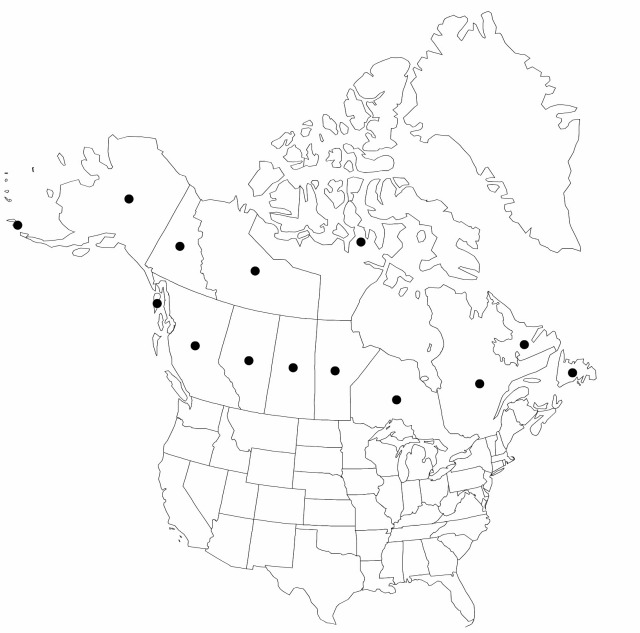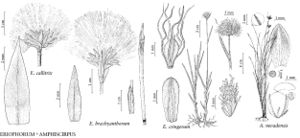Difference between revisions of "Eriophorum brachyantherum"
in A. T. von Middendorff, Reise Siber. 1(2, 3): 98. 1856.
FNA>Volume Importer |
GeoffLevin (talk | contribs) m (Fixed italics in discussion) |
||
| (2 intermediate revisions by one other user not shown) | |||
| Line 1: | Line 1: | ||
{{Treatment/ID | {{Treatment/ID | ||
|accepted_name=Eriophorum brachyantherum | |accepted_name=Eriophorum brachyantherum | ||
| − | |accepted_authority=Trautvetter & C. A. Meyer | + | |accepted_authority=Trautvetter & C. A. Meyer |
|publications={{Treatment/Publication | |publications={{Treatment/Publication | ||
|title=in A. T. von Middendorff, Reise Siber. | |title=in A. T. von Middendorff, Reise Siber. | ||
| Line 8: | Line 8: | ||
}} | }} | ||
|common_names=Closed-sheath cotton-grass;linaigrette à anthères courtes | |common_names=Closed-sheath cotton-grass;linaigrette à anthères courtes | ||
| + | |special_status={{Treatment/ID/Special_status | ||
| + | |code=F | ||
| + | |label=Illustrated | ||
| + | }} | ||
|basionyms= | |basionyms= | ||
|synonyms={{Treatment/ID/Synonym | |synonyms={{Treatment/ID/Synonym | ||
| Line 32: | Line 36: | ||
|elevation=0–1500 m | |elevation=0–1500 m | ||
|distribution=Alta.;B.C.;Man.;Nfld. and Labr.;N.W.T.;Nunavut;Ont.;Que.;Sask.;Yukon;Alaska;Eurasia. | |distribution=Alta.;B.C.;Man.;Nfld. and Labr.;N.W.T.;Nunavut;Ont.;Que.;Sask.;Yukon;Alaska;Eurasia. | ||
| − | |discussion=<p><i>Eriophorum brachyantherum</i> var. pellucidum Lepage is ca. 30 cm with narrowly oblong achenes (2.5–2.7 mm). It is known from only a single station (Rupert House, Quebec) and may be a hybrid between <i>E. brachyantherum</i> and <i>E. vaginatum</i> subsp. spissum. Further study is needed to determine the status of this plant.</p> | + | |discussion=<p><i>Eriophorum brachyantherum</i> var. <i>pellucidum</i> Lepage is ca. 30 cm with narrowly oblong achenes (2.5–2.7 mm). It is known from only a single station (Rupert House, Quebec) and may be a hybrid between <i>E. brachyantherum</i> and <i>E. vaginatum</i> subsp. <i>spissum</i>. Further study is needed to determine the status of this plant.</p> |
|tables= | |tables= | ||
|references= | |references= | ||
| Line 41: | Line 45: | ||
-->{{#Taxon: | -->{{#Taxon: | ||
name=Eriophorum brachyantherum | name=Eriophorum brachyantherum | ||
| − | |authority=Trautvetter & C. A. Meyer | + | |authority=Trautvetter & C. A. Meyer |
|rank=species | |rank=species | ||
|parent rank=genus | |parent rank=genus | ||
| Line 54: | Line 58: | ||
|publication title=in A. T. von Middendorff, Reise Siber. | |publication title=in A. T. von Middendorff, Reise Siber. | ||
|publication year=1856 | |publication year=1856 | ||
| − | |special status= | + | |special status=Illustrated |
| − | |source xml=https:// | + | |source xml=https://bitbucket.org/aafc-mbb/fna-data-curation/src/2e0870ddd59836b60bcf96646a41e87ea5a5943a/coarse_grained_fna_xml/V23/V23_33.xml |
|genus=Eriophorum | |genus=Eriophorum | ||
|species=Eriophorum brachyantherum | |species=Eriophorum brachyantherum | ||
Latest revision as of 23:02, 2 December 2021
Plants cespitose. Culms terete or nearly so, 20–70 cm, smooth. Leaves: bladeless sheaths 1–3, evenly distributed on culm, distal to middle, not inflated distally, filiform, channeled, 0.4–1.2 mm wide. Inflorescences: involucral bracts absent. Spikelets solitary, erect, globose, 10–20 mm in flower, 20–35 mm in fruit; proximal empty scales usually 7 or more, ascending, blackish, ovate-lanceolate, 5–10 mm, thin, margins broad, ribless, midrib not reaching tip. Flowers: perianth bristles usually more than 8, creamy white to pale brown, 10–20 mm; anthers 0.5–2 mm. Achenes oblanceoloid, (1.8–)2–2.3(–2.7) × 0.5–1.2 mm; apex minutely apiculate, 0.1 mm. 2n = 58.
Phenology: Fruiting summer.
Habitat: Bogs, fens, tundra, muskeg, wet soils
Elevation: 0–1500 m
Distribution

Alta., B.C., Man., Nfld. and Labr., N.W.T., Nunavut, Ont., Que., Sask., Yukon, Alaska, Eurasia.
Discussion
Eriophorum brachyantherum var. pellucidum Lepage is ca. 30 cm with narrowly oblong achenes (2.5–2.7 mm). It is known from only a single station (Rupert House, Quebec) and may be a hybrid between E. brachyantherum and E. vaginatum subsp. spissum. Further study is needed to determine the status of this plant.
Selected References
None.
